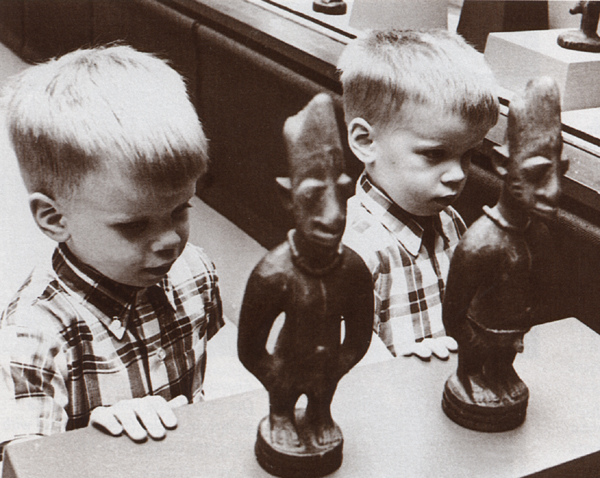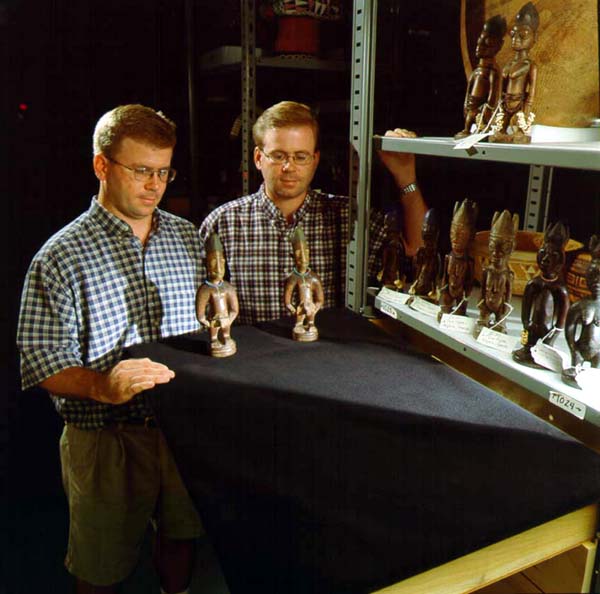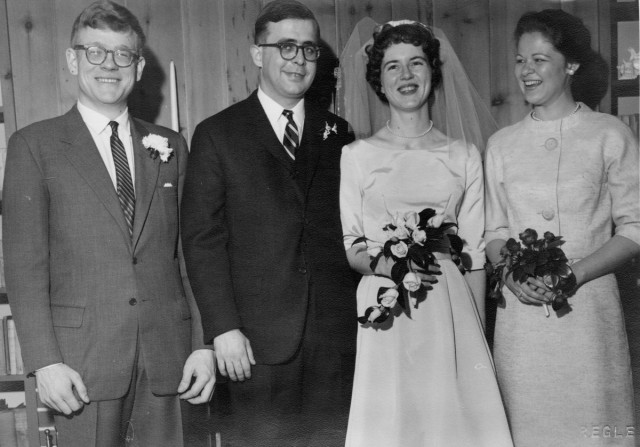- Home
- >
- Preservation Archaeology Blog
- >
- Exegesis of a Southwestern Archaeologist, Part 1
By Steve Nash, Anthropology Department Chair, Denver Museum of Nature & Science
Kiathuthlanna Black-on-White, Yoruba Ibeji, and Me
On July 7, 1967, the Chicago Sun-Times ran a photograph under the caption “Chicago Twins Meet Yoruba Twins” to honor the opening of a new temporary exhibit on Yoruba twin statues, or ibeji, at the Field Museum of Natural History. On the right is my twin brother Peter; we were not yet three years old.

Our father, Edward. G. Nash, was at that time editor of the Field Museum of Natural History Bulletin, and had arranged the photograph. (He was also an editor of the Fieldiana monograph series.) Nowhere in Ed’s wildest dreams could he have predicted that I would one day return to the Museum to serve as a postdoc cataloging Paul Sidney Martin’s archaeological collections (1997–1999), much less being promoted to Head of Collections in the Department of Anthropology (1999–2006).
Even further straining the bounds of credulity, my father could not have predicted that thirty-three years to the day after that photo was published, I would receive a Museum Loan Network grant to photograph the same collection of ibeji. But such is the case, and it constitutes a strange strand in the complex tapestry documenting how I became a museum-based anthropologist and Southwestern archaeologist.
Peter and I, never unwilling to seize an opportunity to surprise our parents, re-staged the photograph, and the museum staff were kind enough to publish it with the original photograph and a short an article in the September/October 2000 issue of In the Field, the Field Museum’s membership newsletter.

We grew up on the University of Chicago campus. Unbeknownst to us, we were surrounded by anthropologists. Shortly after we were born in 1964, Lewis Binford jokingly informed our maternal grandmother that Peter and I had six toes on each foot. (We don’t.) Perhaps he was testing hypotheses and developing middle-range theory, searching for universal laws to describe grandmaternal angst.
In 1967, my parents bought archaeologist George Quimby’s house when he moved to Seattle to become director of the Burke Museum. Quimby had served as a curator at the Field Museum for two decades, so my father had an inside track on the sale. I still have a wonderful cast iron soup tureen that the Quimby family left behind, and which I use on camping trips. I hope the statute of limitations has expired. An artifact, indeed.
In the late 1970s, I served as a paperboy for anthropologists Fred and Dorothy Eggan, who made significant contributions to the study of Native American social organization, and whose work was instrumental in Paul Sidney Martin’s developing archaeological interests on the subject in the 1940s and 1950s. Also on my route was Albert Dahlberg, a pioneer in dental anthropology. Anthropologist Manning Nash was just around the corner.
Our mother, Katie Appleby Nash, worked at the University of Chicago for the better part of four decades, retiring as Dean of Students in 2000. Her best friend in the late 1950s and early 1960s was the late Constance E. Cronin, who went on to a tragically underproductive career as a faculty member in anthropology at the University of Arizona. Cronin was like an aunt to us, living in the Nash household for a time while writing a groundbreaking dissertation on Sicilian peasant communities living in Australia, Chicago, and Italy. Peter and I well remember riding around in the “way back” (i.e. luggage compartment) of the “Connie Bug,” her beloved 1967 VW Beetle. Not safe, but sure fun.
In the early 1960s, and while still a graduate student, Connie became deeply involved in the study of archaeological ceramics from Carter Ranch Pueblo, which her friend William A. Longacre had recently excavated with Martin and others at the Field Museum. Cronin’s ceramic design-element study became a critical contribution to the development of the New Archaeology, which attempted, among other things, to reconstruct prehistoric social organization through ceramics. Although I don’t remember it, my mother was fond of reminding me that our dining room table was occasionally covered in Kiathuthlanna Black-on-white and other sherds.
Whereas my mother was best friends with an anthropologist, my father’s best friend and college roommate at Fordham University was an archaeologist, McGuire Gibson, who still works at the Oriental Institute at the University of Chicago, and recently gave the 22nd annual Sabbaugh lecture at the University of Arizona.
Gibson was also a Chicago graduate student; his dissertation was on collections from the site of Kish, Iraq, which the Field Museum excavated back in the 1920s. As luck would have it, a large portion of the Kish Collection was never catalogued, so when I became Head of Collections in Anthropology at the Field Museum, one of my priorities was to address this gap. I am pleased to report that the Kish Collection is now fully cataloged and accessible, but it took the tragic war and looting of the Iraq Museum to make federal funding become available.

My father left the Field Museum in 1969 to work for Rand McNally, editing science textbooks. I took my first anthropology class in high school, and majored in anthropology and environmental studies at Grinnell College in Iowa, arriving there at the same time as Kathryn Kamp and John Whittaker, who had just earned their doctorates from the University of Arizona.
After taking two years off from school, I entered graduate school at the University of Arizona, where Cronin and Longacre had long-established careers as faculty members. Although I had kept in touch with Cronin over the years, I had never met Longacre—at least while an adult. One day early in my first year of graduate school, I stopped “Uncle Willie”, as he is affectionately known, in the hallway. I explained who I was. After a few awkward and silent moments in which I could see him reconstructing his social and professional genealogies, we laughed together at the cognitive implications of a quarter-century remove.
Tempus fugit.
Steve’s story continues here.
See highlights from the related issue of Archaeology Southwest Magazine, “A New Way of Living”